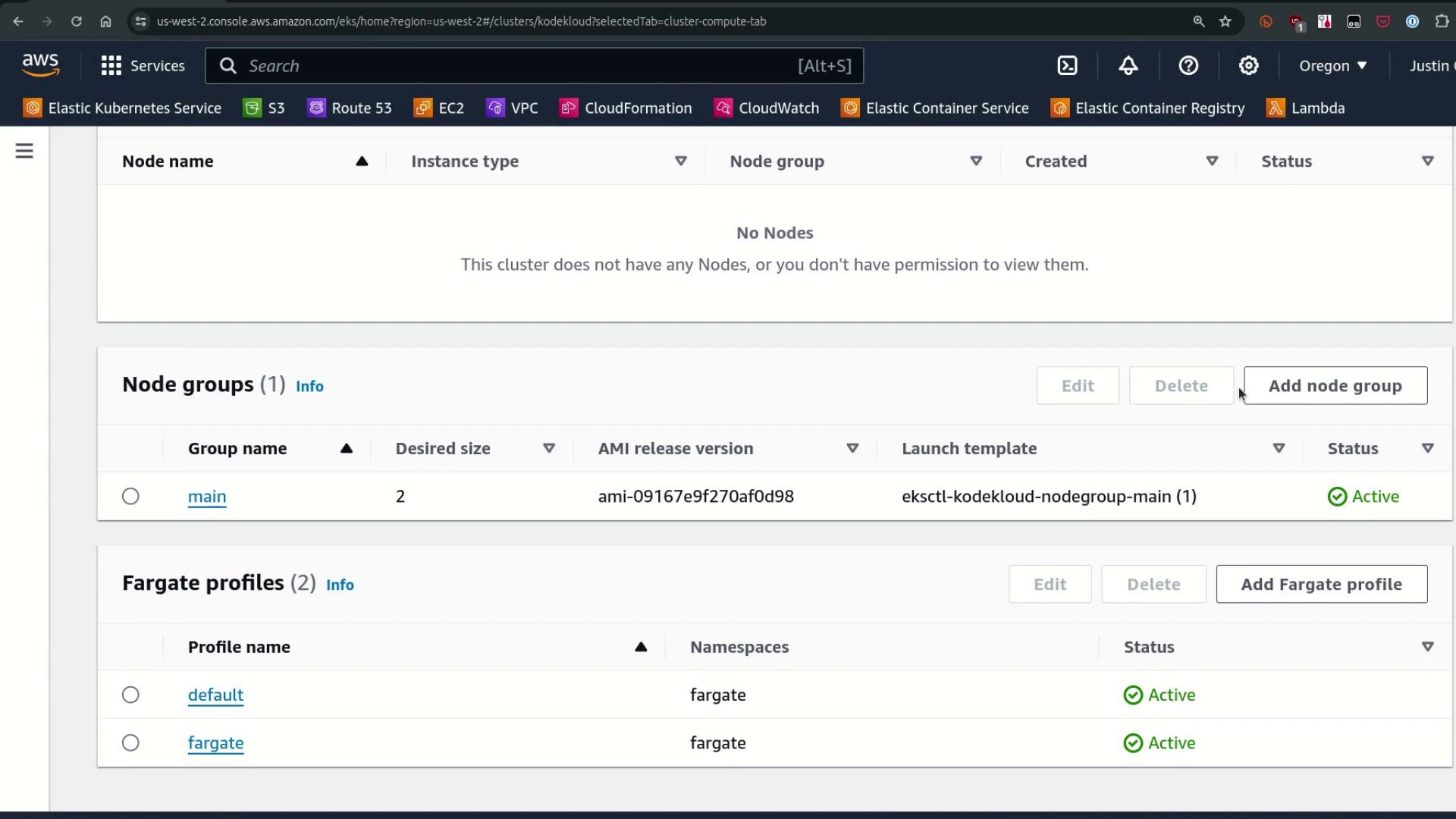AWS EKS
Compute Scaling
Compute Demo
In this guide, we’ll walk through real-time auto scaling on Amazon EKS using three compute options:
- Managed Node Groups
- Fargate Profiles
- Karpenter Provisioner
By the end, you’ll understand how to deploy workloads that scale automatically based on demand.
1. Cluster Setup: Managed Node Group & Fargate Profiles
We’ve created:
- A managed Node Group named main (desired capacity: 2)
- Two Fargate profiles: default and fargate (selects
namespace: fargate)

When you schedule a Pod in the fargate namespace, the Fargate mutating webhook injects a custom scheduler that routes Pods to serverless Fargate compute.

2. Verifying Webhooks & Node Status
First, confirm the Fargate mutation webhook is installed:
kubectl get mutatingwebhookconfigurations.admissionregistration.k8s.io
NAME WEBHOOKS AGE
0500-amazon-eks-fargate-mutation.amazonaws.com 2 4h39m
pod-identity-webhook 1 4h45m
vpc-resource-mutating-webhook 1 4h45m
Next, list the current nodes in your cluster (you should see only the managed nodes):
kubectl get nodes
NAME STATUS ROLES AGE VERSION
i-05b0938045882bc66.us-west-2.compute.internal Ready <none> 4h v1.29.0-eks-5e0fdde
i-0b67dcfad12062f1d.us-west-2.compute.internal Ready <none> 4h v1.29.0-eks-5e0fdde
View the main Node Group details via eksdemo or your preferred CLI:
eksdemo get mng -c kodekloud
+-------+--------+------+-------+-----+-----+-----------------------------+-----------+
| Age | Status | Name | Nodes | Min | Max | Version | Type |
+-------+--------+------+-------+-----+-----+-----------------------------+-----------+
| 4h | ACTIVE | main | 2 | 0 | 10 | ami-09167e9f270af0d8 (eks) | ON_DEMAND |
+-------+--------+------+-------+-----+-----+-----------------------------+-----------+
Note
We currently have no Cluster Autoscaler installed, so we’ll adjust the Node Group sizes manually below.
3. Manual Scaling of the Managed Node Group
To force-scale the main Node Group down to 1 node:
eksdemo update mng main -c kodekloud --min 1 --max 1
Updating nodegroup with 1 Nodes, 1 Max...done
Within a minute, one managed node will terminate.
4. Deploying Workloads to Fargate
Let’s create a namespace and a Deployment that matches the fargate profile:
apiVersion: v1
kind: Namespace
metadata:
name: fargate
---
apiVersion: apps/v1
kind: Deployment
metadata:
name: fargate-nginx
namespace: fargate
spec:
replicas: 1
selector:
matchLabels:
app: fargate-nginx
template:
metadata:
labels:
app: fargate-nginx
spec:
terminationGracePeriodSeconds: 0
containers:
- name: fargate-nginx
image: public.ecr.aws/nginx/nginx:latest
Apply the manifest:
kubectl apply -f fargate-deploy.yaml
Watch the Pod in Pending state until Fargate provisions a node:
kubectl get pods -n fargate --watch
Describe the pending Pod to verify the custom scheduler:
kubectl get pod fargate-nginx-<id> -n fargate -o yaml
spec:
schedulerName: fargate-scheduler
tolerations:
- key: node.kubernetes.io/not-ready
operator: Exists
effect: NoExecute
tolerationSeconds: 300
- key: node.kubernetes.io/unreachable
operator: Exists
effect: NoExecute
tolerationSeconds: 300
Once Fargate provisioning completes, you’ll see a new node:
kubectl get nodes
NAME STATUS
fargate-ip-192-168-138-113.us-west-2.compute.internal Ready
i-05b0938045882bc66.us-west-2.compute.internal Ready
Scale the Fargate deployment to 5 replicas:
kubectl scale deploy fargate-nginx -n fargate --replicas 5
kubectl get pods -n fargate
NAME READY STATUS AGE
fargate-nginx-58f48f6b79-7ggz5 0/1 Pending 4s
fargate-nginx-58f48f6b79-gldtV 0/1 Pending 4s
fargate-nginx-58f48f6b79-h8pzw 0/1 Pending 4s
fargate-nginx-58f48f6b79-p46sq 1/1 Running 2m24s
fargate-nginx-58f48f6b79-sjzxz 0/1 Pending 4s
Note
Fargate creates one node per Pod, which can add provisioning latency for rapid scaling.
5. Standard Nginx Deployment on Managed Nodes
Deploy a typical Nginx workload in the default namespace:
apiVersion: apps/v1
kind: Deployment
metadata:
name: nginx
spec:
replicas: 2
selector:
matchLabels:
app: nginx
template:
metadata:
labels:
app: nginx
spec:
terminationGracePeriodSeconds: 0
containers:
- name: nginx
image: public.ecr.aws/nginx/nginx:latest
kubectl apply -f nginx-deploy.yaml
kubectl get pods
NAME READY STATUS AGE
nginx-56cd7bd595-abcde 1/1 Running 30s
nginx-56cd7bd595-fghij 1/1 Running 30s
These Pods schedule immediately on existing on-demand nodes.
6. Dynamic Scaling with Karpenter
Karpenter automatically provisions compute when Pods remain unscheduled due to resource constraints.
Note
Make sure you’ve installed Karpenter and configured the required IAM roles. See the Karpenter documentation for setup instructions.
Verify Karpenter pods:
kubectl get pods -n kube-system | grep karpenterScale the Nginx deployment to 25 replicas:
kubectl scale deploy nginx --replicas 25Add CPU requests to force new node provisioning:
kubectl set resources deployment nginx --requests=cpu=500mWatch Pods and Nodes:
kubectl get pods --all-namespaces --watch kubectl get nodesExample of new C5 nodes:
NAME STATUS AGE VERSION i-048b7c8a501cda49d.us-west-2.compute.internal Ready 66s v1.29.0-eks-5e0fdde i-0c1d8c0722d4758b1.us-west-2.compute.internal Ready 25s v1.29.0-eks-5e0fdde # ... existing fargate and managed nodes ...Inspect a Karpenter-provisioned node:
kubectl get node i-048b7c8a501cda49d -o yamlmetadata: labels: beta.kubernetes.io/instance-type: c5.2xlarge karpenter.amazonaws.com/instance-family: c5 karpenter.k8s.aws/instance-cpu: "8" karpenter.sh/managed-by: karpenter spec: {}
7. Karpenter Default Provisioner Configuration
View and describe the default Provisioner to see its constraints:
kubectl get provisioners
NAME
default
kubectl get provisioner default -o yaml
spec:
requirements:
- key: kubernetes.io/arch
operator: In
values: ["amd64"]
- key: kubernetes.io/os
operator: In
values: ["linux"]
- key: karpenter.sh/capacity-type
operator: In
values: ["on-demand","spot"]
- key: karpenter.k8s.aws/instance-category
operator: In
values: ["c","m","r"]
- key: karpenter.k8s.aws/instance-generation
operator: Gt
values: ["2"]
limits:
cpu: 1000
status:
resources:
cpu: "16"
memory: 31792072Ki
pods: "116"
This provisioner restricts instances to Linux/AMD64 of category C, M, or R (generation > 2) and allows up to 1,000 CPUs.
8. Summary: EKS Compute Options Comparison
| Compute Option | Description | Characteristics |
|---|---|---|
| Managed Node Group | Always-on EC2 capacity with lifecycle APIs | Stable, version-managed nodes, manual or autoscaled |
| Fargate Profiles | Serverless pods on demand | One node per Pod, isolation, longer startup latency |
| Karpenter | Dynamic, request-driven node provisioning | Fast scale-out, flexible instance types, cost-efficient |
Links and References
Watch Video
Watch video content